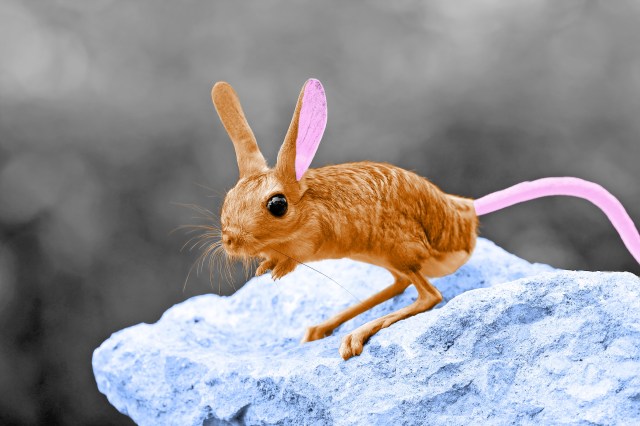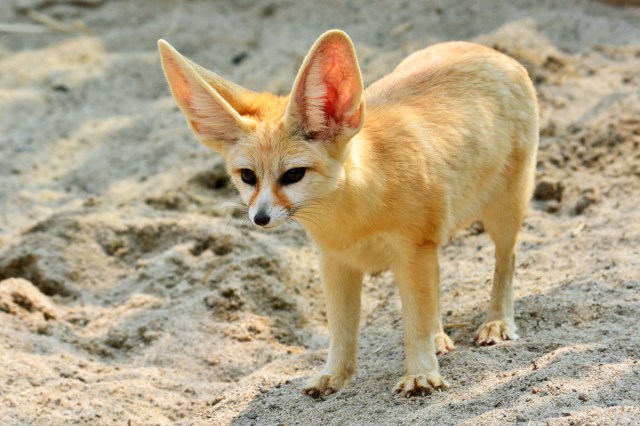
Fennec Fox
Despite being considered the world’s smallest fox, fennec foxes have outlandishly large ears that look as if they should belong to a much bigger animal. The head and body of a fennec fox measures between 9.5 inches and 16 inches, while their ears measure 6 inches long.
This overly large feature makes the critter particularly adorable to look at, but those big ears offer a practical purpose as well. They radiate body heat, allowing fennec foxes to keep cool in the sweltering desert heat, and they also provide the foxes with fantastic hearing, allowing them to detect nearby predators.
Fennec foxes live in the deserts and semi-desert regions of the Sahara and North Africa, where they burrow into the sand during the daytime to beat the heat before emerging at night to feast on insects, rodents, lizards, plants, and more. They also have thick fur that makes them resemble a plush stuffed animal and helps them survive in the harsh desert climate. The fur keeps fennec foxes insulated on cold nights, shields them from the sun on warm days, and protects their feet from being burnt by hot sands.
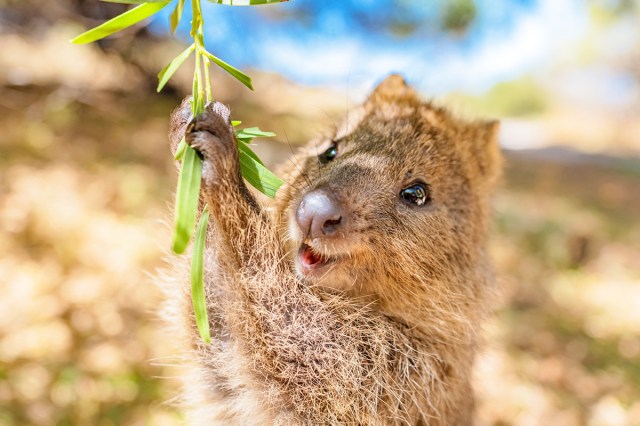
Quokka
The quokka is a little ball of fur that’s native to parts of Western Australia near the city of Perth. They’re quite prevalent on Bald Island and Rottnest Island, the latter of which is home to an estimated 10,000 of this adorable marsupial. Part of what makes quokkas so cute is a combination of their curious nature and their “smiling” faces, especially when taking photos with humans. In a 2019 interview with People, former executive director of Rottnest Island Michelle Reynolds noted, “The quokkas are themselves very inquisitive, so they will look at the camera … And I’ve seen them smiling.”
Quokkas have such a reputation for being photogenic that it led to a mid-2010s social media trend called the #QuokkaSelfie. People flocked Down Under to snap a cute picture with a smiling quokka, including celebrities such as Roger Federer, Margot Robbie, and Hugh Jackman. This trend helped raise awareness and conservation funds in support of these enchanting creatures. If you find yourself with the opportunity to take a photo with a quokka, however, be careful not to touch or feed them — they’re known to bite.
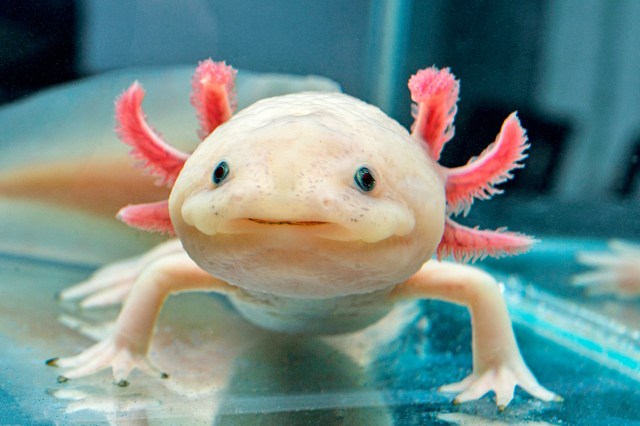
Axolotl
Axolotls are like Peter Pan in the sense that they never really grow up. While most other amphibians undergo a metamorphic process (e.g., a tadpole becoming a frog), the axolotl maintains its juvenile features for life. So even though they can live 10 to 15 years in the wild, these aquatic critters continue to look like a wee youngin’ forever.
Wild axolotls are native to lakes and wetlands in Southern Mexico, and many of the animals you’ll find in the wild have a brown coloration. But axolotls who live in captivity are even cuter, as they tend to have a whitish-pinkish hue that gives them a bright and vibrant appearance.
What’s more, the natural curve of an axolotl’s mouth makes it look like they’re smiling, which adds to their delightful nature. Axolotls are also quite a fascinating biological specimen, as they have the ability to regrow missing limbs and tails, among other parts of their bodies.
More Interesting Reads
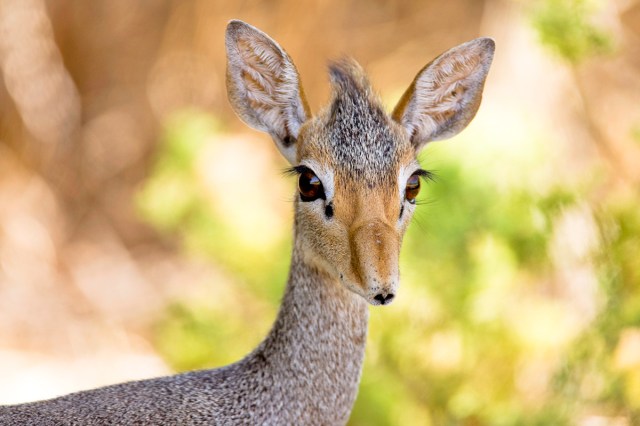
Dik-dik
Despite their cervine appearance and the fact they look as cute as Bambi (if not more so), dik-diks aren’t actually deer. Dik-dik is the name of four distinct species of antelope native to Eastern Africa and Southern Africa. What makes dik-diks so cute is their minute stature, as they only grow to somewhere between 12 and 16 inches and weigh just 7 to 14 pounds. This makes them one of the most diminutive — and adorable — antelope species on Earth.
Much like a Pokémon, dik-diks can actually say their name — well, sort of. The animal got its name because it makes a “dik-dik” sound when it senses nearby predators. But beyond their cute exteriors, dik-diks practice certain behaviors straight out of a sci-fi movie. For instance, they secrete a dark, tar-like liquid from ducts under their eyes to mark their territory, which you may not expect from an animal with such disarmingly huge eyes and cute little horns.
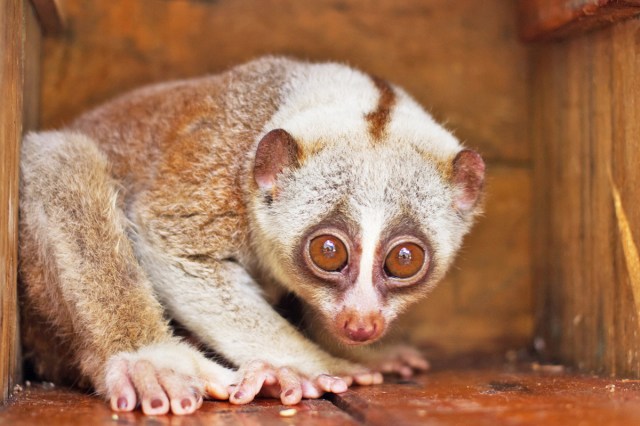
Slow Loris
With its bulging eyes and soft fur, the slow loris is arguably the world’s cutest primate. The average slow loris measures between 6 and 10 inches long and weighs just a pound, making it comparable in size to a squirrel. But the creature’s cartoonishly large eyes — which also contain a reflective layer to provide them with fantastic night vision — lend it a distinctive look that’s right out of aPixar movie.
As their name suggests, slow lorises move at little more than 1 mile per hour, so you’ll have no trouble getting close to snap a picture. But be careful, because their bite is considered toxic; in fact, slow lorises are the sole remaining mammal and only primate to harbor toxins.
These cute critters are native to the tropical forests of Southeast Asia, but sadly, their cuteness has led to some issues. In an interview for BBC Wildlife magazine, wildlife veterinarian Nur Purba Priambada warned, “Their very cuteness has been a major factor in their decline, because people want to keep them as pets.” This phenomenon has caused a spike in the illegal trade of slow lorises, which has negatively impacted their numbers in the wild.
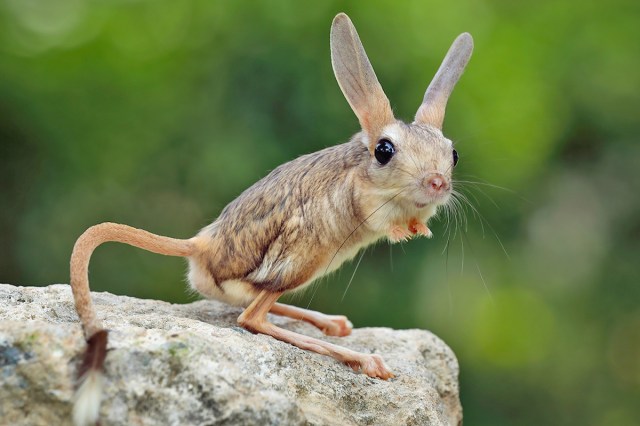
Long-Eared Jerboa
Imagine a cross between a mouse, a rabbit, and a kangaroo, and you’ll likely come up with an approximation of a long-eared jerboa. This tiny rodent is native to the desert areas of China and Southern Mongolia, where its tan-colored fur allows it to blend into its sandy surroundings.
The creature’s rabbit-like ears are a third longer than its head, providing it with keen hearing abilities. The long-eared jerboa also has a snout like a pig and a front set of arms that seem disproportionately small for its body — much like those of a T. rex — all of which contribute to its uniquely endearing appearance.
Its hind legs are incredibly powerful, similar to a kangaroo. In fact, a jerboa can leap up to 10 times its hip height; scientist Talia Moore explains in HowStuffWorks that this is the equivalent of humans “jumping over an Olympic high-dive platform.”

